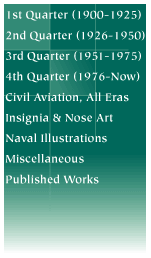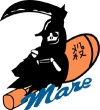
![]()

Modern Day Zero: The Mitsubishi F-1
By Chris Banyai-Riepl
The Mitsubishi F-1 was the first post-WW2 jet designed and built in Japan. While it greatly resembles the SEPECAT Jaguar, the F-1 is actually about three feet longer. Based off of the T-2 trainer, the F-1 first flew in November 1976, and quickly equipped several squadrons of the JASDF. Armament consisted of Sidewinders on wingtip rails, a 20mm cannon in the nose, and underwing stores for carrying 500lb and 750lb bombs. A top speed of Mach 1.6 is reached at 11,000m, with a maximum service ceiling of 15,240m. For their first modern fighter design, the F-1 was more than able to hold its own, and is still in front line service today.

 This
F-1 is from No. 3 Squadron, and features the regular squadron markings
of two red bands outlined in white on the tail, and the samurai head
insignia of the squadron.
This
F-1 is from No. 3 Squadron, and features the regular squadron markings
of two red bands outlined in white on the tail, and the samurai head
insignia of the squadron.
This one also features a sharkmouth, which was quite common on many F-1s and looks quite well on the long, pointed nose.
 The
next F-1 is one of several from No. 6 Squadron painted up in what appears
to be an aerobatic team scheme. Each plane from the lineup featured
a different nose art, with 70-8201 having the example at right. This
one also has two blue stars underneath the windscreen, and a white band
around the rear fuselage.
The
next F-1 is one of several from No. 6 Squadron painted up in what appears
to be an aerobatic team scheme. Each plane from the lineup featured
a different nose art, with 70-8201 having the example at right. This
one also has two blue stars underneath the windscreen, and a white band
around the rear fuselage.

 Several
aircraft were painted up for the 50th anniversary of Tsuiki AB in Japan,
including this F-1. The anniversary badge at right was carried on both
sides of the tail, and the blue/yellow/blue line followed the outline
of the camouflage pattern.
Several
aircraft were painted up for the 50th anniversary of Tsuiki AB in Japan,
including this F-1. The anniversary badge at right was carried on both
sides of the tail, and the blue/yellow/blue line followed the outline
of the camouflage pattern.
Not pictured is the centerline tank, which was painted yellow and depicted all of the aircraft flown from Tsuiki AB since 1942 in silhouette.

 This
F-1 happens to be the same one as the No. 6 Squadron above, only this
time it is in No. 8 Squadron livery, specially painted for a gunnery
contest. The regular squadron markings consist of just the cat on the
tail, so the addition of the black and yellow lightning flashes on the
tail really add something.
This
F-1 happens to be the same one as the No. 6 Squadron above, only this
time it is in No. 8 Squadron livery, specially painted for a gunnery
contest. The regular squadron markings consist of just the cat on the
tail, so the addition of the black and yellow lightning flashes on the
tail really add something.
